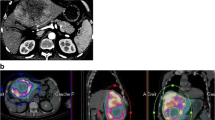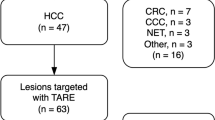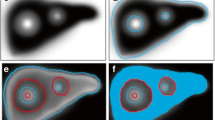Abstract
Purpose
The aim of this study was to establish an algorithm for the prescription of 90Y glass microsphere radioembolization (90Y-GMRE) of HCC in individual patients based on the relationship between tumour dose (TD) and response validated by 90Y PET/CT dosimetry and dual-tracer PET/CT metabolic parameters.
Methods
The study group comprised 62 HCC patients prospectively recruited for 90Y-GMRE who underwent pretreatment dual-tracer (11C-acetate and 18F-FDG) PET/CT as surrogate markers of HCC cellular differentiation. Pretreatment tumour-to-nontumour ratio on 99mTc-MAA SPECT/CT (T/NTMAA) was correlated with posttreatment 90Y PET/CT T/NT90Y after quantification validation. The TD–response relationship for HCC of different tracer groups was assessed on follow-up PET/CT 2 months after treatment.
Results
90Y PET/CT was accurate in the measurement of recovery of injected 90Y activity (81.9–99.9%, median 94.8%). Pretreatment SPECT/CT T/NTMAA was strongly correlated with posttreatment 90Y PET/CT T/NT90Y (5.6 ± 3.2 versus 5.9 ± 3.5, T/NT90Y 1.01 × T/NTMAA + 0.161, r = 0.918, P < 0.05). The response rates were 72.4% (21/29), 70.6% (12/17) and 25% (4/16) for well, moderately and poorly differentiated HCC, respectively. The cut-off TD for a good response was significantly different between poorly differentiated and well/moderately differentiated HCC (262 Gy versus 152/174 Gy) with 89.2% sensitivity and 88% specificity. At a limiting tolerated liver dose of 70 Gy, the T/NTMAA thresholds for predicting a good response in poorly differentiated and well/moderately differentiated HCC were 3.5 and 2.0/2.3. Disregarding HCC cellular differentiation, the cut-off TD became 170 Gy, with lower sensitivity (70.3%) and specificity (76%).
Conclusion
90Y PET/CT can provide accurate dosimetry for 90Y-GMRE. Pretreatment T/NTMAA predicts posttreatment T/NT90Y. The TD thresholds for a good response are tracer-dependent, with a strong correlation between HCC radiosensitivity and cellular differentiation and other PET-based parameters. These cytokinetic factors improve treatment efficacy while minimizing organ damage for the prescription of personalized 90Y-GMRE.





Similar content being viewed by others
References
Salem R, Thurston KG. Radioembolization with 90yttrium microspheres: a state-of-the-art brachytherapy treatment for primary and secondary liver malignancies. Part 1: technical and methodologic considerations. J Vasc Interv Radiol. 2006;17(8):1251–78.
Salem R, Thurston KG. Radioembolization with 90yttrium microspheres: a state-of-the-art brachytherapy treatment for primary and secondary liver malignancies. Part 2: special topics. J Vasc Interv Radiol. 2006;17(9):1425–39.
Salem R, Thurston KG. Radioembolization with yttrium-90 microspheres: a state-of-the-art brachytherapy treatment for primary and secondary liver malignancies: part 3: comprehensive literature review and future direction. J Vasc Interv Radiol. 2006;17(10):1571–93.
Pan CC, Kavanagh BD, Dawson LA, Li XA, Das SK, Miften M, et al. Radiation-associated liver injury. Int J Radiat Oncol Biol Phys. 2010;76(3 Suppl):S94–100.
Benson R, Madan R, Kilambi R, Chander S. Radiation induced liver disease: a clinical update. J Egypt Natl Canc Inst. 2016;28(1):7–11.
Cao X, He N, Sun J, Tan J, Zhang C, Yang J, et al. Hepatic radioembolization with yttrium-90 glass microspheres for treatment of primary liver cancer. Chin Med J. 1999;112(5):430–2.
Garin E. Radioembolization with (90)Y-loaded microspheres: high clinical impact of treatment simulation with MAA-based dosimetry. Eur J Nucl Med Mol Imaging. 2015;42(8):1189–91.
Kao YH, Steinberg JD, Tay YS, Lim GK, Yan J, Townsend DW, et al. Post-radioembolization yttrium-90 PET/CT - part 2: dose-response and tumor predictive dosimetry for resin microspheres. EJNMMI Res. 2013;3(1):57.
Kao YH, Steinberg JD, Tay YS, Lim GK, Yan J, Townsend DW, et al. Post-radioembolization yttrium-90 PET/CT - part 1: diagnostic reporting. EJNMMI Res. 2013;3(1):56.
Willowson KP, Tapner M, QUEST Investigator Team, Bailey DL. A multicentre comparison of quantitative (90)Y PET/CT for dosimetric purposes after radioembolization with resin microspheres: the QUEST Phantom Study. Eur J Nucl Med Mol Imaging. 2015;42(8):1202–22.
Ilhan H, Goritschan A, Paprottka P, Jakobs TF, Fendler WP, Bartenstein P, et al. Systematic evaluation of tumoral 99mTc-MAA uptake using SPECT and SPECT/CT in 502 patients before 90Y radioembolization. J Nucl Med. 2015;56(3):333–8.
Leung WT, Lau WY, Ho SK, Chan M, Leung NW, Lin J, et al. Measuring lung shunting in hepatocellular carcinoma with intrahepatic-arterial technetium-99m macroaggregated albumin. J Nucl Med. 1994;35(1):70–3.
Wahl RL, Jacene H, Kasamon Y, Lodge MA. From RECIST to PERCIST: evolving considerations for PET response criteria in solid tumors. J Nucl Med. 2009;50(Suppl 1):122S–50S.
Ho S, Lau WY, Leung TW, Chan M, Johnson PJ, Li AK. Clinical evaluation of the partition model for estimating radiation doses from yttrium-90 microspheres in the treatment of hepatic cancer. Eur J Nucl Med. 1997;24(3):293–8.
Chiesa C, Mira M, Maccauro M, Romito R, Spreafico C, Sposito C, et al. A dosimetric treatment planning strategy in radioembolization of hepatocarcinoma with 90Y glass microspheres. Q J Nucl Med Mol Imaging. 2012;56(6):503–8.
Lau WY, Leung WT, Ho S, Leung NW, Chan M, Lin J, et al. Treatment of inoperable hepatocellular carcinoma with intrahepatic arterial yttrium-90 microspheres: a phase I and II study. Br J Cancer. 1994;70(5):994–9.
Gulec SA, Sztejnberg ML, Siegel JA, Jevremovic T, Stabin M. Hepatic structural dosimetry in (90)Y microsphere treatment: a Monte Carlo modeling approach based on lobular microanatomy. J Nucl Med. 2010;51(2):301–10.
Haber AH, Rothstein BE. Radiosensitivity and rate of cell division: “law of Bergonie and Tribondeau”. Science. 1969;163(3873):1338–9.
Garin E, Lenoir L, Rolland Y, Edeline J, Mesbah H, Laffont S, et al. Dosimetry based on 99mTc-macroaggregated albumin SPECT/CT accurately predicts tumor response and survival in hepatocellular carcinoma patients treated with 90Y-loaded glass microspheres: preliminary results. J Nucl Med. 2012;53(2):255–63.
Garin E, Rolland Y, Edeline J, Icard N, Lenoir L, Laffont S, et al. Personalized dosimetry with intensification using 90Y-loaded glass microsphere radioembolization induces prolonged overall survival in hepatocellular carcinoma patients with portal vein thrombosis. J Nucl Med. 2015;56(3):339–46.
Ho S, Lau WY, Leung TW, Chan M, Ngar YK, Johnson PJ, et al. Partition model for estimating radiation doses from yttrium-90 microspheres in treating hepatic tumours. Eur J Nucl Med. 1996;23(8):947–52.
Ho S, Lau WY, Leung TW, Chan M, Chan KW, Lee WY, et al. Tumour-to-normal uptake ratio of 90Y microspheres in hepatic cancer assessed with 99Tcm macroaggregated albumin. Br J Radiol. 1997;70(836):823–8.
Lau WY, Sangro B, Chen PJ, Cheng SQ, Chow P, Lee RC, et al. Treatment for hepatocellular carcinoma with portal vein tumor thrombosis: the emerging role for radioembolization using yttrium-90. Oncology. 2013;84(5):311–8.
Srinivas SM, Natarajan N, Kuroiwa J, Gallagher S, Nasr E, Shah SN, et al. Determination of radiation absorbed dose to primary liver tumors and normal liver tissue using post-Radioembolization (90)Y PET. Front Oncol. 2014;4:255.
Lea WB, Tapp KN, Tann M, Hutchins GD, Fletcher JW, Johnson MS. Microsphere localization and dose quantification using positron emission tomography/CT following hepatic intraarterial radioembolization with yttrium-90 in patients with advanced hepatocellular carcinoma. J Vasc Interv Radiol. 2014;25(10):1595–603.
Pawlik TM, Keyomarsi K. Role of cell cycle in mediating sensitivity to radiotherapy. Int J Radiat Oncol Biol Phys. 2004;59(4):928–42.
Elschot M, Nijsen JF, Lam MG, Smits ML, Prince JF, Viergever MA, et al. (99m)Tc-MAA overestimates the absorbed dose to the lungs in radioembolization: a quantitative evaluation in patients treated with 166Ho-microspheres. Eur J Nucl Med Mol Imaging. 2014;41(10):1965–75.
Author information
Authors and Affiliations
Corresponding author
Ethics declarations
Conflicts of interest
None.
Ethical approval
All procedures performed in studies involving human participants were in accordance with the ethical standards of the institutional and/or national research committee and with the principles of the 1964 Declaration of Helsinki and its later amendments or comparable ethical standards.
Informed consent
All patients provided signed informed consent for the treatment, and the treatment was not experimental.
Rights and permissions
About this article
Cite this article
Ho, C.L., Chen, S., Cheung, S.K. et al. Radioembolization with 90Y glass microspheres for hepatocellular carcinoma: significance of pretreatment 11C-acetate and 18F-FDG PET/CT and posttreatment 90Y PET/CT in individualized dose prescription. Eur J Nucl Med Mol Imaging 45, 2110–2121 (2018). https://doi.org/10.1007/s00259-018-4064-6
Received:
Accepted:
Published:
Issue Date:
DOI: https://doi.org/10.1007/s00259-018-4064-6




